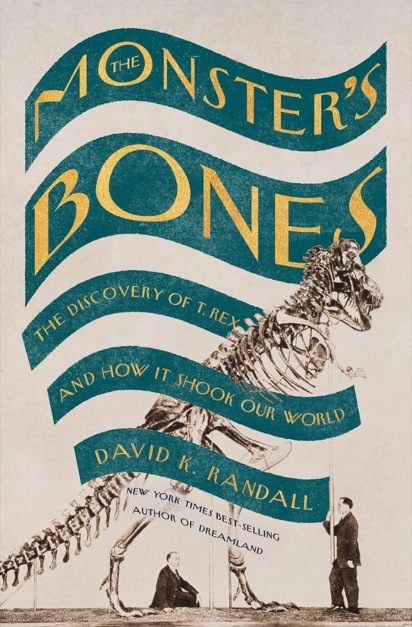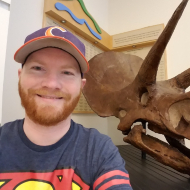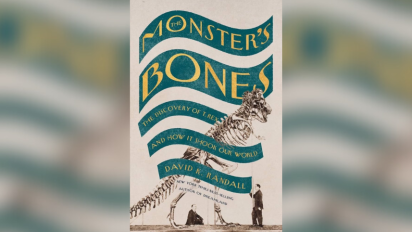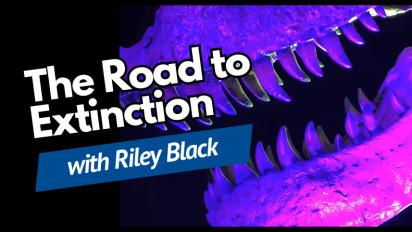[Review] The Monster's Bones: The Discovery of T. Rex and How It Shook Our World
"In The Monster’s Bones, journalist David K. Randall tells the story of how T. rex attained its iconic status," writes our reviewer, NCSE Teacher Ambassador Andy Epton.
Tyrannosaurus rex. It’s probably the first binomial scientific name anybody learns, and for good reason. This dinosaur has shaped our world like no other prehistoric creature before or since its discovery and display. T. rex. The name commands respect (rex means “king”) while its size and its teeth ensure that it gets that respect. In The Monster’s Bones, journalist David K. Randall tells the story of how T. rex attained its iconic status.
 The “king of the tyrant lizards” is the star of the book, as it is the dinosaurian star of our modern lives. From children’s books to blockbuster movies, the prehistoric protagonist of choice is the mighty T. rex. Randall makes the case that the world before the discovery of T. rex was lacking — lacking a common horror, but also lacking a common source of wonder and awe. T. rex gave us these things and more. It frightened young and old alike. It inspired generations to learn about the past. It provided us with the perfect cinematic villain and, later, anti- hero. Without T. rex, we would have no King Kong, nor would we have Barney. This one dinosaur above so many others sparked a cascade of imagination that still pervades our culture today.
The “king of the tyrant lizards” is the star of the book, as it is the dinosaurian star of our modern lives. From children’s books to blockbuster movies, the prehistoric protagonist of choice is the mighty T. rex. Randall makes the case that the world before the discovery of T. rex was lacking — lacking a common horror, but also lacking a common source of wonder and awe. T. rex gave us these things and more. It frightened young and old alike. It inspired generations to learn about the past. It provided us with the perfect cinematic villain and, later, anti- hero. Without T. rex, we would have no King Kong, nor would we have Barney. This one dinosaur above so many others sparked a cascade of imagination that still pervades our culture today.
The book bills itself as telling the story of discovering T. rex by focusing on its discoverer, Barnum Brown. However, the book is, in a sense, a four-part biography, as it weaves together the histories of T. rex, Brown, Henry Fairfield Osborn, and the American Museum of Natural History. Barnum Brown stands out, of course, but he needed an employer or a benefactor or both. He also needed a place to send and display his discoveries. These four icons of American paleontology simply would not be what they are today without one another.
Amid this notable lineup, Randall highlights the dynamic nature of paleontology in the nineteenth century. We learn of the “Bone Wars” waged between Othniel C. Marsh and Edward Drinker Cope. Though not the main subject of the book, this conflict is used to illustrate the colorful character of early paleontology. The author admirably stays neutral in the descriptions of both sides, leaving the reader wanting to know more about them. Randall also informs the reader about England’s precursor to the American “Bone Wars” when country doctor Gideon Mantell went up against the establishment figure Sir Richard Owen. It was Owen who gave us the term “dinosaur” and described many of the early British species. But it was Mantell who discovered the first herbivorous dinosaur in Iguanodon.
T. rex was at the center of a third feud. Henry Fairfield Osborn of the American Museum of Natural History in New York had a long-running rivalry with Andrew Carnegie of the Carnegie Museum in Pittsburgh. Osborn wanted a relevant museum that could rival and perhaps even surpass the Carnegie Museum. After all, the AMNH is in cosmopolitan New York while the Carnegie Museum is located amid the smoke-choked hills of Pittsburgh. Yet it was Osborn who was playing catch-up. Carnegie had money and spent lavishly to get the best materials and the biggest dinosaurs. Osborn wanted something no one could ignore. To supply it, he called upon Barnum Brown.
Brown was indefatigable in the field and could weather the heat, dust, cold, flies, storms, and anything else the western frontier and badlands could muster. On an expedition to find a Triceratops skull for the AMNH in the Hell Creek Formation in Montana, Brown found his, and Osborn’s, legacy. It took weeks to remove, months to prepare, and years to place on display. Once it was on display, however, the world was never the same. For decades, the only place in the world to see T. rex was in New York City at the AMNH.
“Every child that attends a natural history museum on a field trip has Barnum Brown — and the T. rex — to thank,” writes Randall (page 235). With the discovery and display of T. rex, the way dinosaurs were mounted changed, the way the public viewed dinosaurs changed, and the way we viewed Earth’s past changed. T. rex gave us a cultural and scientific icon for the ages. Barnum Brown gave us Tyrannosaurus rex.







